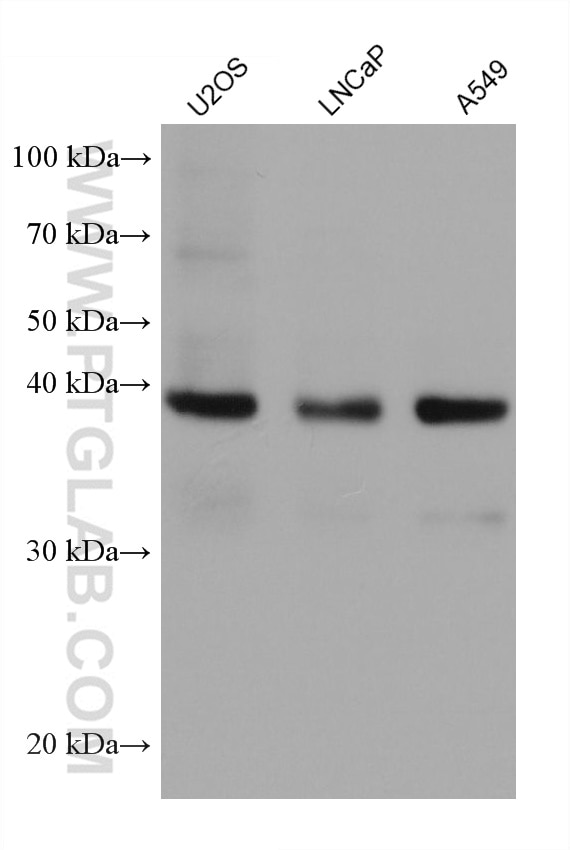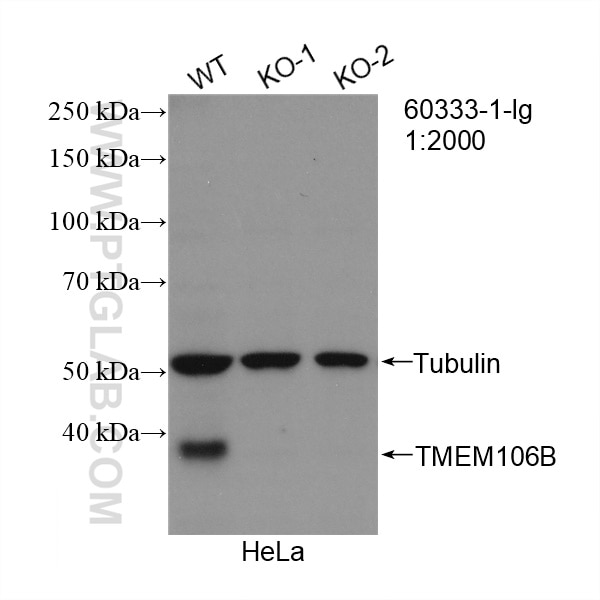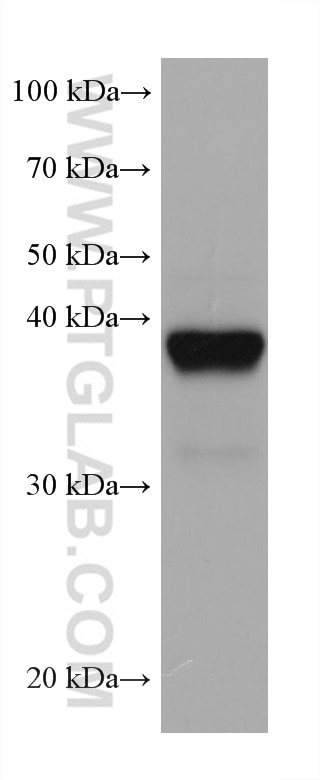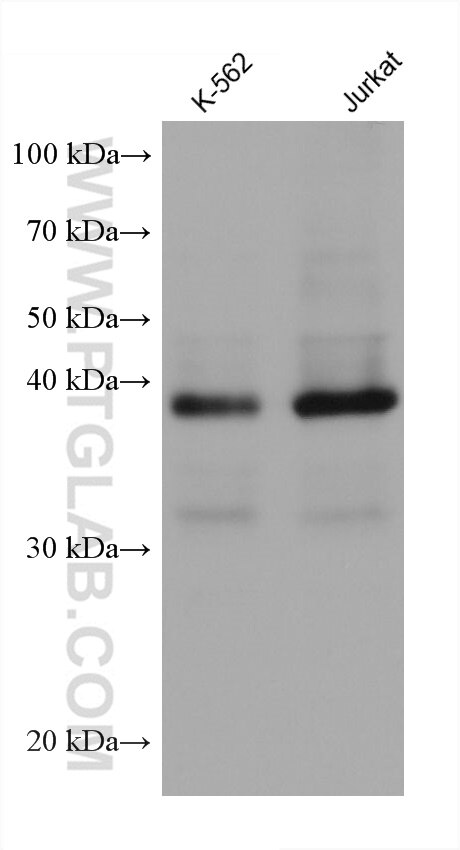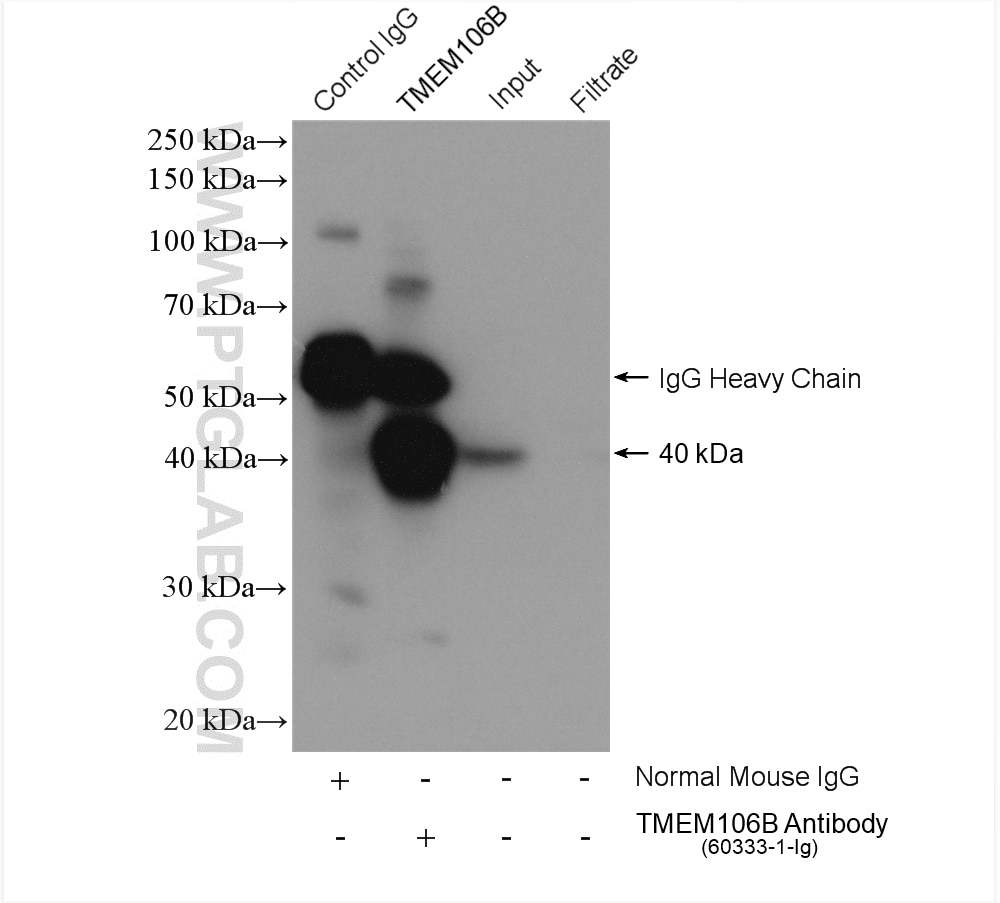- Featured Product
- KD/KO Validated
TMEM106B Monoklonaler Antikörper
TMEM106B Monoklonal Antikörper für IP, WB, ELISA
Wirt / Isotyp
Maus / IgG1
Getestete Reaktivität
human
Anwendung
WB, IP, IHC, ELISA
Konjugation
Unkonjugiert
CloneNo.
5D1F8
Kat-Nr. : 60333-1-Ig
Synonyme
Galerie der Validierungsdaten
Geprüfte Anwendungen
| Erfolgreiche Detektion in WB | U2OS-Zellen, A549-Zellen, HeLa-Zellen, Jurkat-Zellen, K-562-Zellen, LNCaP-Zellen |
| Erfolgreiche IP | HeLa-Zellen |
Empfohlene Verdünnung
| Anwendung | Verdünnung |
|---|---|
| Western Blot (WB) | WB : 1:5000-1:50000 |
| Immunpräzipitation (IP) | IP : 0.5-4.0 ug for 1.0-3.0 mg of total protein lysate |
| It is recommended that this reagent should be titrated in each testing system to obtain optimal results. | |
| Sample-dependent, check data in validation data gallery | |
Veröffentlichte Anwendungen
| KD/KO | See 1 publications below |
| WB | See 3 publications below |
| IHC | See 2 publications below |
Produktinformation
60333-1-Ig bindet in WB, IP, IHC, ELISA TMEM106B und zeigt Reaktivität mit human
| Getestete Reaktivität | human |
| In Publikationen genannte Reaktivität | human |
| Wirt / Isotyp | Maus / IgG1 |
| Klonalität | Monoklonal |
| Typ | Antikörper |
| Immunogen | TMEM106B fusion protein Ag21448 |
| Vollständiger Name | transmembrane protein 106B |
| Berechnetes Molekulargewicht | 31 kDa |
| Beobachtetes Molekulargewicht | ~40 kDa |
| GenBank-Zugangsnummer | BC033901 |
| Gene symbol | TMEM106B |
| Gene ID (NCBI) | 54664 |
| Konjugation | Unkonjugiert |
| Form | Liquid |
| Reinigungsmethode | Protein-G-Reinigung |
| Lagerungspuffer | PBS mit 0.02% Natriumazid und 50% Glycerin pH 7.3. |
| Lagerungsbedingungen | Bei -20°C lagern. Nach dem Versand ein Jahr lang stabil Aliquotieren ist bei -20oC Lagerung nicht notwendig. 20ul Größen enthalten 0,1% BSA. |
Hintergrundinformationen
TMEM106B is a genetic risk factor for frontotemporal lobar degeneration with TDP-43 inclusions (FTLD-TDP). Amyotrophic lateral sclerosis (ALS), like FTLD-TDP, is characterized by pathological TDP-43 inclusions. TMEM106B expression in the brain may be linked to mechanisms of disease in FTLD-TDP and risk alleles confer genetic susceptibility by increasing gene expression.
Protokolle
| Produktspezifische Protokolle | |
|---|---|
| WB protocol for TMEM106B antibody 60333-1-Ig | Protokoll herunterladen |
| IP protocol for TMEM106B antibody 60333-1-Ig | Protokoll herunterladen |
| Standard-Protokolle | |
|---|---|
| Klicken Sie hier, um unsere Standardprotokolle anzuzeigen |
Publikationen
| Species | Application | Title |
|---|---|---|
Brain C-terminal TMEM106B fragments in human brain correlate with disease-associated TMEM106B haplotypes | ||
Pathol Res Pract TESC acts as a prognostic factor and promotes epithelial-mesenchymal transition progression in esophageal squamous carcinoma | ||
Acta Neuropathol Accumulation of TMEM106B C-terminal fragments in neurodegenerative disease and aging | ||
Front Cell Neurosci Loss of TMEM106B exacerbates C9ALS/FTD DPR pathology by disrupting autophagosome maturation
|
